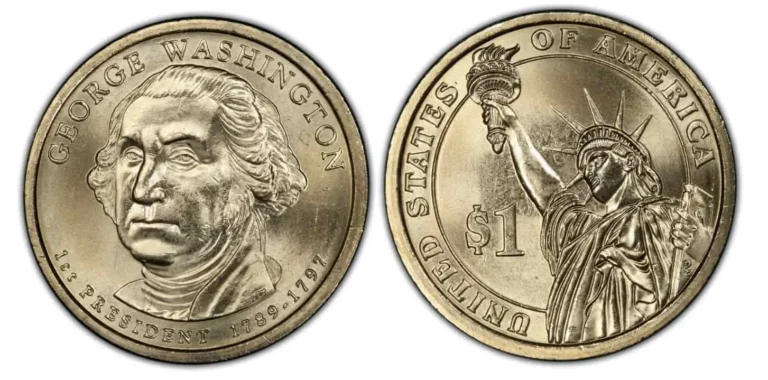George Washington 1 Dollar Coin – History & Value
Have you ever found a shiny, golden-hued dollar coin in your change and wondered about its story? The George Washington 1 dollar coin, the first in the U.S. Mint’s Presidential $1 Coin Program, is more than just pocket change—it’s a tribute to America’s founding father and a collectible piece of history. Released in 2007, this coin kicked off a series honoring U.S. presidents, blending historical significance with modern craftsmanship. Whether you’re a seasoned numismatist or a curious beginner, this coin offers a fascinating journey into America’s past, its currency challenges, and the allure of rare finds like error coins. In this article, we’ll explore the coin’s history, design, value, and tips for collectors, making it your go-to guide for everything about the George Washington 1 dollar coin. Let’s dive in!
Historical Context of the George Washington 1 Dollar Coin
The Presidential $1 Coin Program
In 2005, Congress passed the Presidential $1 Coin Act, launching a bold initiative to honor deceased U.S. presidents through a series of dollar coins. The program, which began in 2007, aimed to release four coins annually, each featuring a president in the order of their service. The George Washington 1 dollar coin was the inaugural release, hitting circulation on February 15, 2007, near Presidents’ Day. The U.S. Mint designed the program not only to celebrate America’s leaders but also to encourage the use of dollar coins over paper bills, which wear out faster. Despite this goal, the coins faced challenges in gaining widespread acceptance, a topic we’ll revisit later.
George Washington’s Legacy
George Washington, America’s first president from 1789 to 1797, is a towering figure in U.S. history. As a Revolutionary War hero and the architect of the young nation’s government, he set precedents that shaped the presidency. Featuring him on the first coin was a fitting choice, symbolizing leadership and unity. Washington’s image on U.S. currency isn’t new—his portrait has graced coins since the 1790s, including early silver dollars. The Presidential dollar coin program chose him to lead the series, connecting modern numismatics to the origins of American coinage under the Coinage Act of 1792.
Design and Specifications of the George Washington 1 Dollar Coin
Obverse and Reverse Design
The George Washington 1 dollar coin boasts a striking design that captures both history and artistry. The obverse, crafted by sculptor Joseph Menna, features a detailed portrait of Washington facing left, inspired by classic depictions. Inscriptions include “George Washington,” “1st President,” and his term, “1789–1797.” The reverse, designed by Don Everhart, showcases the Statue of Liberty, a unifying symbol across all Presidential dollar coins. This design choice reflects America’s enduring values of freedom and democracy.
A standout feature is the coin’s edge, which carries inscriptions like “In God We Trust,” “E Pluribus Unum,” the mint mark (P for Philadelphia or D for Denver), and the year 2007. This edge lettering, a nod to early U.S. coins, adds a unique tactile element. However, it also led to some famous minting errors, which we’ll explore later.
Material and Specifications
The George Washington dollar coin design is as practical as it is beautiful. Made from a manganese-brass alloy (88.5% copper, 6% zinc, 3.5% manganese, 2% nickel), the coin has a distinctive golden color, setting it apart from silver-toned predecessors like the Susan B. Anthony dollar. It measures 26.5 mm in diameter and weighs 8.1 grams, slightly larger and heavier than a quarter. Compared to the Sacagawea dollar, it shares the same composition but stands out with its presidential theme. These U.S. dollar coin specifications make it durable for circulation while appealing to collectors.
Mintage and Circulation
Production Details
The U.S. Mint produced the George Washington 1 dollar coin in large quantities to ensure availability. In 2007, Philadelphia minted 176,680,000 coins, while Denver produced 163,680,000 for circulation. Additionally, the San Francisco Mint struck proof versions for collectors, featuring sharper details and a polished finish. By 2011, the Mint halted circulation production for the Presidential series due to low demand, shifting focus to collector sets. This decision makes early coins like Washington’s more significant, as they were widely circulated.
Circulation Challenges
Despite high hopes, the George Washington dollar coin mintage didn’t translate to widespread use. Many Americans preferred paper dollar bills, leading to millions of coins sitting in Federal Reserve vaults. The U.S. Mint launched initiatives like the Circulating $1 Coin Direct Ship Program, allowing businesses to order coins directly, but adoption remained low. By 2016, the program’s circulation phase ended, with later coins produced solely for collectors. This struggle highlights the challenge of shifting public habits in a digital age, yet the coin remains a numismatic gem.
Must Read About: Profitable Intraday Trading Advice 66unblockedgames.com
Collectible Value and Rarity
Standard Coin Value
For collectors, the George Washington dollar coin value depends on condition and rarity. In circulated condition, these coins are worth face value—$1. Uncirculated coins in mint condition typically fetch $1.50 to $2, according to recent data from PCGS CoinFacts. High-grade examples, graded MS67 or above by services like PCGS or NGC, can command $10 or more. The coin’s accessibility makes it an excellent entry point for new collectors, but its true value lies in rare variants.
Error Coins and Their Appeal
The George Washington dollar coin errors are a collector’s dream. The most famous is the “Godless dollar,” where coins left the Mint without edge lettering, omitting “In God We Trust.” These errors sparked controversy in 2007, with some claiming the omission was intentional, though it was a minting mistake. Such coins initially sold for $600 or more, though prices have settled to $50–$100 for high-grade examples, per CoinValueChecker.com. Other errors include doubled edge lettering and blank planchets, each adding to the coin’s allure. These rare George Washington coins attract numismatists for their scarcity and historical intrigue.
Gold-Plated and Colorized Editions
Some collectible dollar coins are enhanced after minting, with private companies offering gold-plated or colorized versions. These are not official U.S. Mint products but appeal to niche collectors. Gold-plated coins might sell for $5–$20, while colorized versions, featuring painted designs, are more decorative than valuable. Collectors should focus on original Mint coins for investment potential, as enhancements rarely increase intrinsic worth.
Historical and Cultural Significance
Commemorating American History
The George Washington 1 dollar coin serves as an educational tool, introducing younger generations to Washington’s pivotal role in founding the United States. As the first president, he established traditions like the two-term limit and a strong executive branch. The coin’s release in 2007 coincided with efforts to revitalize interest in U.S. history through currency. Compared to earlier George Washington commemorative coins, like the 1982 Half Dollar or the 1951–1954 Washington–Carver Half Dollar, this coin continues a tradition of honoring his legacy.
Numismatic Legacy
Washington’s image on U.S. coins dates back to the 1790s, when early silver dollars bore his likeness. The U.S. numismatic history tied to Washington reflects the Mint’s evolution, from the Coinage Act of 1792 to modern commemorative programs. The 2007 dollar coin bridges this history, combining traditional edge lettering with contemporary design. Its place in the Presidential series underscores the Mint’s mission to blend art, history, and innovation.
Tips for Collectors
Identifying Valuable Coins
Starting a George Washington coin collecting journey is exciting and accessible. To spot valuable coins, check the edge for errors like missing or doubled lettering. Use a magnifying glass to inspect details, and consider professional grading from PCGS or NGC for high-value finds. Resources like Numista offer detailed guides on identifying errors. Always store coins in protective holders to preserve condition.
Building a Collection
You can find George Washington 1 dollar coins in circulation, though they’re less common today. Check eBay, coin shops, or U.S. Mint rolls for uncirculated or proof coins. For beginners, numismatic tips include starting with affordable coins, learning about grading, and avoiding overhyped aftermarket products. Join online communities like Reddit’s r/coins for advice and inspiration. Collecting these coins is a rewarding way to connect with history.
The George Washington 1 dollar coin is more than a piece of currency—it’s a tangible link to America’s founding era and a testament to the U.S. Mint’s artistry. From its role in the Presidential coin collecting series to its rare error variants, this coin captivates collectors and history buffs alike. Whether you’re hunting for a “Godless dollar” or building a set of Presidential coins, the George Washington dollar offers endless intrigue. Next time you find one in your change, take a closer look—you might be holding a piece of history. Visit a local coin shop or browse eBay to start your collection today!







